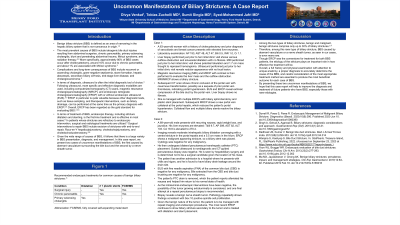Tuesday Poster Session
Category: Biliary/Pancreas
P2941 - Uncommon Manifestations of Biliary Strictures
Tuesday, October 24, 2023
10:30 AM - 4:00 PM PT
Location: Exhibit Hall

Has Audio

Divya Venkat, BS
Wayne State University School of Medicine
West Bloomfield, MI
Presenting Author(s)
Divya Venkat, BS1, Tobias Zuchelli, MD2, Sumit Singla, MD2, Syed-Mohammed Jafri, MD3
1Wayne State University School of Medicine, West Bloomfield, MI; 2Henry Ford Hospital, Detroit, MI; 3Henry Ford Health System, Detroit, MI
Introduction: Benign biliary stricture (BBS) is defined as an area of narrowing in the hepatic biliary system that is non-cancerous in origin. We present unique cases of uncommon manifestations of BBS, caused by aberrant vasculature surrounding the bile duct and a nerve sheath tumor respectively.
Case Description/Methods: A 63-year-old woman with a history of cholecystectomy and prior diagnosis of sarcoidosis and breast cancer presents with elevated liver enzymes. Magnetic resonance imaging (MRI) and magnetic resonance cholangiopancreatography (MRCP) show biliary stricture. Computed tomography (CT) scan shows chronic occlusion of the portal vein with cavernous transformation, possibly as a sequela of prior portal vein thrombosis, indicating portal hypertension. Endoscopic ultrasound (EUS) and endoscopic retrograde cholangiopancreatography (ERCP) reveal extrinsic compression of the bile duct by the portal vein. Liver biopsy shows no fibrosis. She is managed with multiple ERCPs with sphincterotomy. Subsequent MRCP shows a new portal vein collateral at the porta hepatis, which reduces the patient’s portal hypertension. Collateral flow and multiple biliary stents resolve the biliary stricture.
A 69-year-old male presents with recurring nausea, rapid weight loss, and jaundice. His liver enzymes are elevated, and CA 19-9 is elevated to 270.4. Imaging reveals moderate intrahepatic biliary dilatation converging with a central stricture in the porta hepatis and a 5.5 cm mass in the hilum, with biopsies revealing a benign nerve sheath tumor. Pathology repeatedly shows findings consistent with Sox 10 positive spindle cell proliferation. Given the benign nature of the tumor, the patient is to be managed with repeat imaging and endoscopic procedures. The most recent ERCP continues to show biliary stricture secondary to the tumor and is treated with dilatation and stent placement.
Discussion: The most prevalent causes of BBS include iatrogenic bile duct injuries, chronic pancreatitis, and primary sclerosing cholangitis. Treatments include endoscopic therapy, such as stricture dilatation and stenting, and radiological and surgical interventions, such as excision of strictures with end-to-end repair, Roux-en-Y hepaticojejunostomy, choledochojejunostomy, and choledoduodenostomy. Among the two types of biliary strictures, benign and malignant, benign strictures are rarer. BBS caused by aberrant vasculature or a nerve sheath tumor, as seen in our cases, is even more rare.
Disclosures:
Divya Venkat, BS1, Tobias Zuchelli, MD2, Sumit Singla, MD2, Syed-Mohammed Jafri, MD3. P2941 - Uncommon Manifestations of Biliary Strictures, ACG 2023 Annual Scientific Meeting Abstracts. Vancouver, BC, Canada: American College of Gastroenterology.
1Wayne State University School of Medicine, West Bloomfield, MI; 2Henry Ford Hospital, Detroit, MI; 3Henry Ford Health System, Detroit, MI
Introduction: Benign biliary stricture (BBS) is defined as an area of narrowing in the hepatic biliary system that is non-cancerous in origin. We present unique cases of uncommon manifestations of BBS, caused by aberrant vasculature surrounding the bile duct and a nerve sheath tumor respectively.
Case Description/Methods: A 63-year-old woman with a history of cholecystectomy and prior diagnosis of sarcoidosis and breast cancer presents with elevated liver enzymes. Magnetic resonance imaging (MRI) and magnetic resonance cholangiopancreatography (MRCP) show biliary stricture. Computed tomography (CT) scan shows chronic occlusion of the portal vein with cavernous transformation, possibly as a sequela of prior portal vein thrombosis, indicating portal hypertension. Endoscopic ultrasound (EUS) and endoscopic retrograde cholangiopancreatography (ERCP) reveal extrinsic compression of the bile duct by the portal vein. Liver biopsy shows no fibrosis. She is managed with multiple ERCPs with sphincterotomy. Subsequent MRCP shows a new portal vein collateral at the porta hepatis, which reduces the patient’s portal hypertension. Collateral flow and multiple biliary stents resolve the biliary stricture.
A 69-year-old male presents with recurring nausea, rapid weight loss, and jaundice. His liver enzymes are elevated, and CA 19-9 is elevated to 270.4. Imaging reveals moderate intrahepatic biliary dilatation converging with a central stricture in the porta hepatis and a 5.5 cm mass in the hilum, with biopsies revealing a benign nerve sheath tumor. Pathology repeatedly shows findings consistent with Sox 10 positive spindle cell proliferation. Given the benign nature of the tumor, the patient is to be managed with repeat imaging and endoscopic procedures. The most recent ERCP continues to show biliary stricture secondary to the tumor and is treated with dilatation and stent placement.
Discussion: The most prevalent causes of BBS include iatrogenic bile duct injuries, chronic pancreatitis, and primary sclerosing cholangitis. Treatments include endoscopic therapy, such as stricture dilatation and stenting, and radiological and surgical interventions, such as excision of strictures with end-to-end repair, Roux-en-Y hepaticojejunostomy, choledochojejunostomy, and choledoduodenostomy. Among the two types of biliary strictures, benign and malignant, benign strictures are rarer. BBS caused by aberrant vasculature or a nerve sheath tumor, as seen in our cases, is even more rare.
Disclosures:
Divya Venkat indicated no relevant financial relationships.
Tobias Zuchelli: Boston Scientific – Consultant.
Sumit Singla: Boston Scientific – Consultant.
Syed-Mohammed Jafri: Gilead, Takeda, Abbvie – Advisor or Review Panel Member, Speakers Bureau.
Divya Venkat, BS1, Tobias Zuchelli, MD2, Sumit Singla, MD2, Syed-Mohammed Jafri, MD3. P2941 - Uncommon Manifestations of Biliary Strictures, ACG 2023 Annual Scientific Meeting Abstracts. Vancouver, BC, Canada: American College of Gastroenterology.
